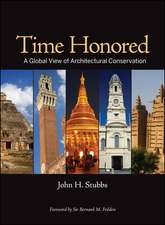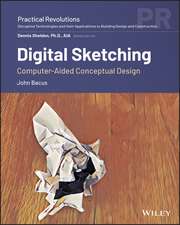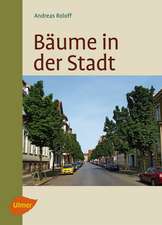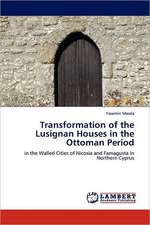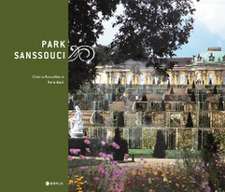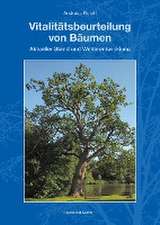Urban Tree Management: For the Sustainable Development of Green Cities
Editat de Andreas Roloffen Limba Engleză Paperback – 28 ian 2016
- Grundlagen, Methoden und Werkzeuge des urbanen Baummanagements
- aktuelle Informationen zu Urban Forestry und Baumbiologie
- positive Effekte und Einsatzmoglichkeiten von Stadtbaumen
- Eigenschaften von, Anforderungen an und Auswahlkriterien fur Stadtbaume
- Zustand und Probleme von Stadtbaumen
- Governance- und Managementaspekte
- Programme im Rahmen der Umwelterziehung Urban Tree Management, herausgegeben von dem fuhrenden Experten Dr. Andreas Roloff, ist ein ausgezeichnetes Referenzwerk fur Pflanzenwissenschaftler, Gartenbauer, Dendrologen, Baumpfleger, Forstwissenschaftler, Stadtplaner, Experten fur Parkanlagen und Landschaftsarchitekten. Dieses Praktikerbuch ist eine wichtige Erganzung fur Studierende einschlagiger Fachrichtungen und fur Bibliotheken.
Preț: 589.64 lei
Preț vechi: 765.77 lei
-23% Nou
Puncte Express: 884
Preț estimativ în valută:
112.88€ • 117.33$ • 93.59£
112.88€ • 117.33$ • 93.59£
Carte tipărită la comandă
Livrare economică 05-19 februarie 25
Preluare comenzi: 021 569.72.76
Specificații
ISBN-13: 9781118954584
ISBN-10: 1118954580
Pagini: 288
Dimensiuni: 170 x 244 x 14 mm
Greutate: 0.57 kg
Editura: Wiley
Locul publicării:Chichester, United Kingdom
ISBN-10: 1118954580
Pagini: 288
Dimensiuni: 170 x 244 x 14 mm
Greutate: 0.57 kg
Editura: Wiley
Locul publicării:Chichester, United Kingdom
Public țintă
Primary Market:Horticulturists, dendrologists (woody plant specialist), arborists and arboriculturists (professionals involved in the cultivation of trees) forestry scientists, city planners, parks department specialists, landscape architects,
Secondary Market:
Students studying courses in, e.g. urban forestry, arboriculture, landscape architecture
Cuprins
List of contributors, xiii 1 Intro: Urban trees - Importance, benefits, problems, 1 Andreas Roloff 1.1 Introduction, 1 1.2 Aesthetics, sensory impressions, 1 1.3 Psychology, well?]being, health, 3 1.4 Environmental education, ecology, 9 1.5 Orientation, spacious ordering, architecture, 9 1.6 Protection, quality of life, 9 1.7 Food/diet, healing powers, 11 1.8 Utilization of trees, 11 1.9 Economic and social advantages, 11 1.10 Issues, 12 1.11 Conclusion, 13 References, 13 2 Urban trees: Features and requirements, 15 Andreas Roloff 2.1 Urban tree site categories, 15 2.2 Special conditions for urban trees, 15 2.3 Requirements and selection criteria, 15 2.4 Conclusions, 19 References, 19 3 Fundamentals of tree biology for urban trees, 20 Doris Krabel 3.1 Morphological and anatomical features, 20 3.1.1 Trunk, 20 3.1.2 Roots, 22 3.1.3 Mycorrhizae, 24 3.1.4 Secondary growth, 25 3.1.5 Periderm and bark, 27 3.2 Tree growth and growth reactions, 28 3.2.1 Photosynthesis - the fundamental growth process, 28 3.2.2 The role of water, 29 3.2.3 Seasonal dynamics, 30 3.2.4 Wound reactions, 31 3.3 Conclusions, 33 References, 34 4 Urban tree roots: Problems and peculiarities, 36 Sandra Korn 4.1 Damages to and influences on the root system of urban trees, 36 4.1.1 Site conditions, 36 4.1.2 Human activity, 37 4.1.3 Construction sites, 39 4.2 Damage caused by the root system of urban trees, 41 4.3 Precautions/preventing damage, 43 4.4 Conclusions, 44 References, 45 5 Drought stress: Adaptation strategies, 47 Sandra Korn 5.1 What is stress? - Stress concepts, 47 5.2 Stress responses, 47 5.2.1 Adaptation to drought stress - stress escape, 48 5.2.2 Adaptation to drought stress - stress resistance by avoidance, 49 5.2.3 Adaptation to drought stress - stress resistance by tolerance, 51 5.3 Identifying tree species adapted to stress, 53 5.3.1 Responses and adaptations to drought stress, 53 5.3.2 Identifying suitable tree species, 53 5.4 Conclusions, 56 References, 56 6 Aspects of urban tree pathology, 58 Rolf Kehr 6.1 Definitions, terms and concepts, 58 6.2 Abiotic damage and disorders, 59 6.3 Virus diseases, 61 6.4 Diseases caused by bacteria and other prokaryotes, 61 6.5 Diseases caused by oomycetes, 64 6.6 Fungal diseases, 65 6.6.1 Systemic fungal infections, 65 6.6.2 Leaf and needle diseases, 67 6.6.3 Shoot and stem diseases and cankers, 68 6.6.4 Rust diseases, 70 6.6.5 Root diseases, 70 6.6.6 Wood decay, 71 6.7 Parasitic plants, 72 6.8 Plant?]parasitic nematodes and insect pests, 73 6.9 Damage by herbivorous mammals, 76 6.10 Impact of introduced pests and diseases, 76 6.11 Aspects of control methods for pests and diseases of urban trees, 76 6.12 Conclusions, 77 References, 77 7 Vitality assessment, tree architecture, 82 Andreas Roloff 7.1 Introduction, 82 7.2 Decline and stress symptoms of tree crowns: "leaf loss" vs. crown structure, 82 7.3 Tree architecture and reiterations, 83 7.3.1 Architectural models, 83 7.3.2 Reiterations, 85 7.4 Changes in the crown structure with decreasing vitality, 87 7.4.1 Shoot morphology: shoot base scars, short?] and long?]shoots, 87 7.4.2 Model of growth stages, 88 7.4.3 Vitality classes, 90 7.4.4 Vitality and tree life expectancy, 92 7.5 Conclusions, 94 References, 94 8 Body language of trees, tree diagnostics, 95 Andreas Roloff 8.1 Terms and definition, 95 8.2 Adaptation and optimization in trees, 95 8.3 Examples and explanation: branches, trunk/bark, roots, 96 8.3.1 Branch?]shedding collar, 96 8.3.2 Hazard beams, 97 8.3.3 Bottle butts, 98 8.3.4 Forked trees, 98 8.3.5 Nose?]like ribs on forked trees, 99 8.3.6 Sunburn, 99 8.3.7 Stem crack, 100 8.3.8 Longitudinal splitting, 100 8.3.9 Knobs and nodules, 100 8.3.10 Bark stripes on ribs, 102 8.3.11 Supply shadow, 103 8.3.12 Elephant's foot, 103 8.3.13 Hollow trunks, 104 8.3.14 Crown/root relationship, 104 8.3.15 Root symphysis, 105 8.3.16 Tension roots on slopes, 105 8.3.17 Covered root collars, 106 8.3.18 Root collar strangling, 107 8.3.19 Sealing of the root area, 107 8.3.20 Inner roots, 108 8.3.21 Adventitious roots, 108 8.4 Conclusions, 109 References, 110 9 Tree inventory, risk assessment and management, 111 Steffen Rust 9.1 Introduction, 111 9.2 Tree inventory, 112 9.2.1 Inventory parameters, 112 9.2.2 Technology, 112 9.3 Tree risk assessment, 113 9.3.1 Terms and concepts, 113 9.3.2 Visual assessment, 115 9.3.3 Advanced assessment, 122 9.3.4 Risk categorization and reporting, 130 9.4 Conclusions, 132 References, 132 10 Tree preservation, maintenance and repair, 135 Steffen Rust 10.1 Introduction, 135 10.2 Preserving existing trees during development, 135 10.2.1 Tree constraints plan, 136 10.2.2 Tree survey, 136 10.2.3 Root protection area, 138 10.2.4 Tree Protection Plan, 138 10.2.5 Arboricultural method statement, 138 10.2.6 Pre?]development treatments, 139 10.3 Maintenance of planted and established trees, 139 10.3.1 Physical support, 139 10.3.2 Protection against collisions, 143 10.3.3 Solar radiation, 144 10.3.4 Wound treatment, 144 10.3.5 Water management, 144 10.3.6 Mulching, 146 10.3.7 Mycorrhizae, 148 10.3.8 Soil compaction, 148 10.3.9 De?]icing salt, 150 10.3.10 Pruning to mitigate risk, 150 10.3.11 Ancient and veteran trees, 151 10.3.12 Precautionary measures, 151 10.4 Conclusions, 152 References, 153 11 Tree pruning: Methods and parameters, 154 Ulrich Pietzarka 11.1 Introduction, 154 11.2 Consequences of pruning, 154 11.3 Important parameters, 157 11.4 The pruning system, 160 11.4.1 Palms, 162 11.5 Intensity of pruning, 164 11.6 Date of pruning, 165 11.6.1 Reduction of assimilates and reserves, 166 11.6.2 Species and nature conservation, 167 11.6.3 Hazard of fungal infestation, 167 11.6.4 Risk of sunburn, 167 11.6.5 Severe frost, 167 11.6.6 Visibility, 167 11.7 Conclusion, 168 References, 168 12 Transplanting large trees, 169 Ulrich Pietzarka 12.1 Introduction, 169 12.2 Definitions, tasks, decisions, 169 12.3 Preparation, 172 12.4 Transplantation practices, 173 12.5 Post?]planting care, 175 12.6 Conclusion, 175 References, 175 13 Dust and noise reduction, 177 Britt Kniesel 13.1 Dust, 177 13.1.1 Dust definition and origins, 177 13.1.2 Interaction between dust particles and vegetation, 177 13.1.3 Planting design, 180 13.2 Noise, 180 13.2.1 Noise control, 180 13.2.2 Noise attenuation by vegetation, 180 13.2.3 Planting design, 182 13.3 Conclusions, 183 References, 183 14 Invasive species, indigenous vs. alien dendroflora, 185 Matthias Meyer 14.1 Introduction, 185 14.2 Floristic statuses - important definitions for urban dendroflora, 185 14.2.1 "Indigenous" vs. "alien", 186 14.2.2 "Casual" and "naturalized" vs. "invasive", 187 14.3 Invasibility of habitats and invasiveness of dendroflora in urban landscapes, 188 14.4 Arguments pro or contra "alien" woody species and risk assessment, 189 14.5 The example of the tree of heaven (Ailanthus altissima), 190 14.6 Prevention and control measures against invasive woody species or tree weeds, 191 14.7 Conclusions, 193 References, 193 15 Criteria for species selection: Development of a database for urban trees, 196 Sten Gillner, Mathias Hofmann, Andreas Tharang and Juliane Vogt 15.1 Introduction, 196 15.2 Species description, growth conditions, and risks related to species use, 198 15.2.1 Data pool and nomenclature, 198 15.2.2 Literature review and evaluation, 198 15.2.3 Structure of the database, 199 15.3 Urban Tree Location Categorization, 199 15.3.1 Urban tree location types, 202 15.3.2 Specific demographic groups, 204 15.4 Psychological aspects of the database, 205 15.4.1 User?]based urban green space categorization, 205 15.4.2 Tree perception and tree preferences, 206 15.5 Application possibilities and limitation of use, 207 15.6 Conclusions, 208 References, 209 16 Genetic aspects, 211 Doris Krabel 16.1 The problem of trees from a genetic point of view, 211 16.2 Diversity, monoculture, variety and clones - some general comments, 214 16.3 The risk of missing diversity, 215 16.4 Genetic diversity as an element of design and planning in urban spaces, 217 16.5 Conclusions, 219 References, 219 17 Governance in urban forestry, 221 Jürgen Pretzsch 17.1 Introduction: challenges and need for action, 221 17.2 Objectives and definitions, 221 17.2.1 Objectives, 221 17.2.2 Definitions, 222 17.3 Diagnosis and conceptual framework, 222 17.3.1 Socio?]ecological co?]evolution model for urban forestry, 222 17.3.2 Historical development of urban forestry governance, 223 17.3.3 Increasing complexity and paradigm change, 224 17.3.4 Stakeholder analysis and differentiation in participant groups, 225 17.3.5 Assessment by the livelihood framework, 226 17.4 Governance models for urban forestry, 227 17.4.1 Introduction to urban forestry governance models, 227 17.4.2 Public administration: changing functions and diversification, 227 17.4.3 Public?]private partnerships, 228 17.4.4 Governance based on private urban forestry, 228 17.4.5 Donations, 228 17.4.6 Allotment gardens, 228 17.4.7 Neighborhood groups and collective gardening, 230 17.5 Lessons learned for the future development of urban forestry, 230 17.5.1 Paradigm change, 230 17.5.2 Chances and limits of collective action in urban forestry, 231 17.5.3 Exclusion and conflict management, 231 17.5.4 Adaptive management, 231 17.5.5 Forthcoming steps in practice and research, 232 17.6 Conclusions, 232 References, 234 18 Allotment gardens and privately managed green space in urban environment, 236 Eckhard Auch 18.1 Introduction, 236 18.2 Some definitions, 236 18.2.1 Green space as urban soft infrastructure, 236 18.2.2 Urban gardening vs. urban horticulture, agriculture and agroforestry, 237 18.3 Urban gardens, 237 18.3.1 Generic types of urban gardens, 237 18.3.2 Urban gardens in history, 238 18.3.3 Urban gardens for the disadvantaged in the 20th Century, 239 18.4 Function and benefits/services of trees and gardens in urban contexts, 241 18.5 Recent forms of urban gardening in the global North and global South, 242 18.5.1 Factors facilitating the emergence, 242 18.5.2 Newer urban garden forms (selection), 243 18.6 Conclusions, 245 References, 245 19 Urban woods for relaxation and inspiration, 247 Eckhard Auch, Hubertus Pohris and Markus Biernath 19.1 Introduction, 247 19.2 Some definitions, 247 19.3 Forest ecosystem functions and services, 248 19.4 Changing demands on urban and peri?]urban forests - the case of Dresden, 251 19.4.1 Change in forest functions, 251 19.4.2 Functional transformation of the Dresdner Heide forest, with focus on recreation, 251 19.5 Urban forestry and silviculture, 254 19.5.1 Urban forests as recreational resource, 254 19.5.2 Silvicultural operations for recreational resources, 254 19.6 Silvicultural specifics of urban and peri?]urban forest management, 256 19.7 Conclusions, 259 References, 259 20 Acceptance for urban trees: Environmental education programs, 262 Ulrich Pietzarka 20.1 Introduction, 262 20.2 Education for sustainable development, 262 20.3 Features of successful education programs, 264 20.3.1 Specific to target groups, 264 20.3.2 Inviting, 266 20.3.3 Focused, 266 20.3.4 Relevant, 267 20.3.5 Active, 267 20.3.6 Entertaining, 268 20.4 The search for professional partners, 268 20.5 Conclusions, 269 References, 270 Index, 271

